The year 2020 will go down in history as the year of the coronavirus, the epidemic that resulted in a global crisis next to which other world events paled in comparison. For the cybersecurity industry, this was also a complex year in which sophisticated breaches occurred while the demand for security innovation skyrocketed.
So, we decided to put together a few thoughts on the past, present, and future in the wake of this latest cyberattack:
#1 There Will Be Another SolarWinds
There is always going to be yet another event that will make headlines when it comes to security. This year ended with the SolarWinds attack, but make no mistake, there are going to be more events of that nature in the future.
As we all knew but were somewhat reluctant to admit, even security companies are not immune to risk exposure. Which really means that cyber hygiene and adhering to fundamental IT operational measures is key to protecting any organization, regardless of size, vertical, or geography. This also means that when a vendor releases a security update, like in the case of SolarWinds, the target audience should quickly deploy the necessary update across the entire spectrum of affected devices, a task which is so often overlooked or delayed or not fully executed. With so many sophisticated attack vectors, it eventually always comes back to the basics.
And in this regard, Patch Management is at the core.
#2 WFH Is Not Going Away (Nor Are the Associated Security Concerns)
The dramatic acceleration in people working from home has changed corporate life, maybe forever. By now, all organizations have found their balance, whether in hybrid models or by going 100% remote. People who had always thought this was impossible saw this reality unfold before their eyes, very quickly—in a matter of weeks and days, not months.
After speed and connectivity were addressed, there came the security challenge. This one, though, is still not fully solved. Although secure connectivity can be achieved using SSL and software-defined perimeter solutions, the sensitive spots are the devices themselves. Employees require constant updates to their workstations and business applications, a constant effort that many companies still struggle with. The challenge of how to enforce those updates without impacting user productivity while still maintaining security is annoying, to say the least.
As WFH becomes the new normal, security fundamentals for endpoints become yet another basic IT requirement, which must be handled remotely.
And in this regard, Patch Management is at the core.
#3 The Hybrid Hassle
Cloud migration is an IT project every company is actively pursuing, one way or another. Every CIO has a “journey to the cloud” initiative. It’s fashionable. Many of those companies have on-premises deployments and are slowly shifting their infrastructure, living in hybrid environments that now need to be maintained, only, it’s now a double effort.
Additionally, many companies are adding various Linux flavors to their infrastructure, as Linux becomes the preferred OS infrastructure of choice. Switching between Windows and Linux, while adding a touch of legacy OS, clearly creates the “perfect storm” in the eyes of IT, who need to handle a distributed complex infrastructure.
In 2020, companies struggled to keep their security fundamentals intact, using a variety of tools, teams, and processes—some of them fairly manual—to try to maintain a satisfactory compliance level of their hybrid environment. Yet, incidents like SolarWinds and FireEye indicate that “best effort” is simply not good enough.
And in this regard, Patch Management is at the core.
#4 Get Ready to Fight, Together
Finally, in 2021, we expect to see a shift in how security and IT work hand-in-hand to combat cyber threats and how the boundaries between teams somewhat dissolve via shared responsibility to safeguard the organization.
For this amalgamation to succeed, there is an immediate need for automation and intelligence to streamline processes, instill process governance, and drive operational efficiency. With a complex infrastructure, remote workforce, and ever-growing stream of cyberthreats, the work of IT and security teams has become more challenging than ever. Having the right set of tools with the right checks and balances will minimize cyber risk and increase the chance of reacting quickly in an event of a crisis.
People always rise to the occasion when there is a superordinate goal. In 2020, COVID-19 was such a goal, and although the situation is far from ideal, it seems there is already a path to healing for 2021. When it comes down to future cyberattacks in 2021, we still have work to do: We have to rally up the troops to work in better harmony and coordination to achieve that superordinate goal of battling cyberattacks.
And in this regard, Patch Management is at the core.
At JetPatch, we are laser-focused on helping our customers and partners transform their patch remediation operations into a modern and intelligent effort, shared by both IT and Security. If your organization is looking to take the step toward next-generation remediation, eliminate silos, and build smart automation into your mix, our experts will be happy to learn more about your particular needs and share with you how other customers have overcome issues and achieved their goals using JetPatch.
After all, Patch Management is at the core.



